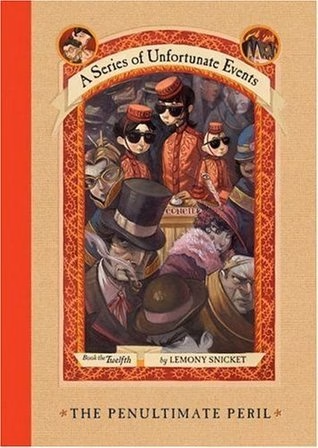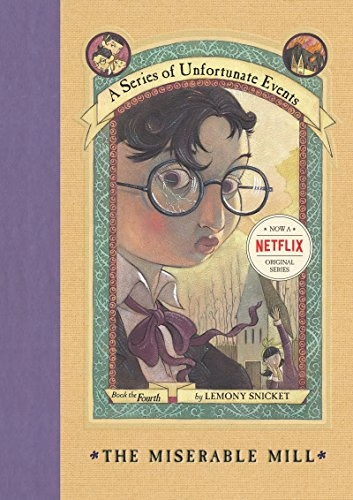Plot Summary:
The Arrival and the Mission
The Baudelaire orphans—Violet, Klaus, and Sunny—are picked up in a taxi by a mysterious, pregnant, and distraught woman named Kit Snicket. She is a member of the secret organization V.F.D. and is rushing the children to their next assignment. As they drive through the city, passing familiar locations from their past misfortunes, Kit explains that V.F.D. has been fractured by a “schism” into two warring factions: one that extinguishes fires (both literal and figurative) and one that starts them, led by villains like Count Olaf.
Their destination is the Hotel Denouement, the penultimate safe place for V.F.D. volunteers. A large gathering is scheduled for Thursday, but Kit has received a coded message that an impostor, using the initials “J.S.,” has already checked in. The Baudelaires’ mission is to disguise themselves as concierges, act as flaneurs (discreet observers), and determine if this “J.S.” is a noble volunteer or a wicked villain. They must also ensure that a crucial V.F.D. artifact, the sugar bowl, falls into the right hands.
Kit explains the hotel is full of both volunteers and villains, all gathered in anticipation of Thursday. The children must rely on their own judgment to tell them apart. She provides them with concierge uniforms and reveals that one of the hotel managers, Frank, is a volunteer, but his identical twin brother, Ernest, is a villain. After a picnic brunch by a perplexing pond that reflects the hotel, Kit departs on her own mission, leaving the children to throw a stone into the pond as a signal to Frank.
Infiltration and Separate Errands
The Baudelaires enter the bustling Hotel Denouement, a building organized according to the Dewey Decimal System, where each floor and room number corresponds to a subject category. They are immediately greeted by a tall, skinny manager who could be either Frank or Ernest; his unfathomable demeanor makes it impossible to tell. They encounter both brothers, who give them conflicting but equally mysterious instructions.
Almost immediately, three concierge bells ring, forcing the siblings to split up.
* Violet to the Rooftop Sunbathing Salon: Violet is summoned to the roof, where she finds Count Olaf’s girlfriend, Esmé Squalor, the journalist Geraldine Julienne, and the spoiled Carmelita Spats. Esmé, wearing ridiculous “sunoculars” to watch the sky, is planning a cocktail party. Carmelita, dressed as a “ballplaying cowboy superhero soldier pirate,” demands a harpoon gun. Overhearing their conversation, Violet learns they are anticipating an arrival by air and that Esmé knows about a “J.S.” lurking in the basement. Violet is forced by a manager (Frank or Ernest) to retrieve a hidden harpoon gun and deliver it to Carmelita.
* Klaus to the Lumber Room (674): Klaus finds his cruel former guardian, Sir, and his kinder partner, Charles, from Lucky Smells Lumbermill. They have been invited to the hotel by “J.S.” and are looking for the Baudelaires. Klaus eavesdrops on them in the sauna (Room 613), learning that Sir is here for business while Charles is concerned for the orphans’ welfare. A manager (Frank or Ernest) interrupts them and instructs Klaus to hang a large sheet of sticky birdpaper out the sauna window, dangling over the pond.
* Sunny to the Education Room (371): Sunny finds her former educators from Prufrock Prep: Vice Principal Nero, Mr. Remora, and Mrs. Bass. They have also been lured to the hotel by Count Olaf with promises of fame, bananas, and opportunities to measure valuables. Sunny escorts them to an Indian restaurant (Room 954), run by Hal from Heimlich Hospital. In the kitchen, she overhears Hal and a manager (Frank or Ernest) discussing a “Vision Furthering Device,” crows, and the laundering of “sugar.” The manager then gives Sunny a special V.F.D. lock and instructs her to place it on the laundry room door (Room 025) in the basement, turning it into a “Vernacularly Fastened Door.”
The Denouement Unravels
That night, the siblings reconvene in the quiet lobby. Like the blind men and the elephant from a poem their father used to recite, they realize each has only observed a small piece of a much larger puzzle. Piecing their clues together, they deduce Count Olaf’s plan:
* Esmé is watching the sky for V.F.D. crows delivering the sugar bowl.
* Carmelita will use the harpoon gun to shoot down the crows.
* The dead crows and the sugar bowl will fall onto the sticky birdpaper.
* The sugar bowl will then drop into a laundry room funnel, landing in the now-locked laundry room.
As they process this, a figure descends from the clock on the lobby ceiling. He introduces himself as Dewey Denouement, the third, unknown triplet brother. He is a “sub-sub-librarian” and the true keeper of the hotel’s greatest secret. The entire V.F.D. catalog—a complete record of every secret, crime, and piece of evidence since the schism—is not in the hotel, but in an identical, underwater structure at the bottom of the pond, a perfect reflection of the hotel above. Dewey reveals that Thursday’s gathering is actually a trial, where all the evidence against Count Olaf will be presented to the High Court. At that moment, two figures arrive by taxi: Justice Strauss and Jerome Squalor, revealing themselves to be the mysterious “J.S.” they were sent to investigate.
Confrontation and Tragedy
The reunion is cut short by the appearance of Count Olaf. A tense confrontation ensues. Olaf demands to know the location of the sugar bowl. His henchmen (Hugo, Colette, and Kevin, disguised as hotel staff) reveal how they observed the Baudelaires inadvertently helping with Olaf’s scheme. Olaf threatens Dewey with the harpoon gun.
In a moment of bravery, the Baudelaires shield Dewey with their own bodies, trying to wrestle the weapon from Olaf’s grasp. Suddenly, the perpetually coughing banker, Mr. Poe, enters the lobby. Startled, Olaf shoves the harpoon gun into the children’s hands. The weapon slips, hits the floor, and fires, fatally striking Dewey Denouement. As guests awaken and a mob forms, Dewey stumbles outside and sinks into the pond, his last word being “Kit.”
The Trial and the Fire
The lobby descends into chaos. A blindfolded trial is convened, presided over not only by Justice Strauss but also by two of Olaf’s most evil associates: the man with a beard but no hair, and the woman with hair but no beard. Realizing the trial is a sham, the Baudelaires remove their blindfolds, only to see Count Olaf kidnapping Justice Strauss and escaping toward an elevator.
The Baudelaires pursue him. In the basement, Klaus, feigning allegiance, helps Olaf unlock the laundry room, knowing the sugar bowl isn’t there. Olaf is enraged to find the room empty. At this point, Sunny, in a shocking turn, suggests they burn down the hotel. Her siblings realize her plan: the fire will act as the V.F.D. signal Kit Snicket was watching for, warning volunteers that the last safe place has been compromised and the gathering is canceled.
They start a fire in the laundry room using Jerome Squalor’s book, Odious Lusting After Finance, as kindling. They then board an elevator with Olaf and the captive Justice Strauss. In a clever prank, they press the button for every floor, allowing them to stop briefly on each level to warn the blindfolded guests—both villains and volunteers—of the fire as they ascend. Their warnings are met with confusion and disbelief.
Escape from the Penultimate Peril
They reach the roof. The hotel is burning, and the structure is beginning to weaken. Violet rigs a drag chute from bedsheets, attaching it to Carmelita’s boat. Justice Strauss pleads with the children to stay and face the authorities, but they refuse, believing the justice system is corrupt. Sunny bites the judge’s hand, forcing her to let go of the boat.
With Count Olaf aboard, the Baudelaires push the boat off the roof. The drag chute slows their descent, and they glide safely into the sea below. As they float away from the burning Hotel Denouement, they are now fugitives, arsonists, and, in the eyes of the world, murderers. Count Olaf declares, “We’re all in the same boat,” and the Baudelaires look out at the open sea, their destinies more uncertain and intertwined with their nemesis than ever before.
Characters
Violet, Klaus, and Sunny Baudelaire
In this penultimate installment, the Baudelaires complete their transformation from victims of circumstance to active, morally complex agents. They are no longer merely children; as Kit Snicket states, they are “volunteers.” Their mission as concierges forces them to operate with cunning and deception, blurring the line between noble observation and treacherous participation. Their decision to start the fire is the ultimate expression of this ambiguity: an act of arson committed for the noble purpose of sending a signal, saving lives even as it destroys the last safe place. Their escape with Count Olaf cements their status as outcasts, forced to abandon a corrupt society to forge their own path.
Count Olaf
Olaf remains the story’s central villain, but his control is visibly fraying. His theatrical troupe is falling apart due to infighting, his relationship with Esmé collapses, and his plans are repeatedly foiled by his own arrogance and the Baudelaires’ ingenuity. He is still driven by greed for the Baudelaire fortune and obsession with the sugar bowl, but his actions seem increasingly desperate. By the end, he is forced into an uneasy alliance with the orphans, a passenger in a boat they command, highlighting the inescapable, symbiotic nature of their relationship.
Dewey Denouement
Dewey is the tragic heart of the book. As the secret third triplet and the “sub-sub-librarian,” he embodies the hidden, noble side of V.F.D. He is the quiet keeper of all knowledge, a guardian of truth in a world of “smoke and mirrors.” His life’s work, the underwater V.F.D. catalog, represents the hope of clarity and justice. His accidental death at the hands of the Baudelaires is the “penultimate peril,” a catastrophic event that shatters the hope of a simple resolution and forces the children into their final, desperate choices.
Justice Strauss and Jerome Squalor
Representing the well-intentioned but ultimately ineffectual adult world, J.S. and J.S. return seeking redemption. Justice Strauss has been trying to bring Olaf to justice through the proper legal channels, while Jerome has chronicled injustice in his book. However, their faith in established systems proves naive. The High Court is corrupt, and their attempts to help are easily subverted. Justice Strauss’s final plea for the Baudelaires to trust the authorities underscores her failure to grasp the depth of the world’s wickedness, a world the children now understand far better than she does.
Core Themes
Moral Ambiguity
This is the book’s central, overwhelming theme. The clear lines between “noble” and “wicked” dissolve completely. The Baudelaires must lie, steal, aid a villain (by retrieving the harpoon gun), and commit arson to achieve their goals. They realize that in a corrupt world, noble intentions often require treacherous actions. The narrative constantly asks whether one can remain good while doing bad things, culminating in the children’s final, morally gray decision to escape with Count Olaf rather than face a flawed system of justice. The phrase “noble enough” becomes a recurring motif, suggesting that perfect nobility is an impossible standard.
The Fragmentation of Knowledge and Truth
The Hotel Denouement, organized by the Dewey Decimal System, is a physical manifestation of knowledge being categorized and compartmentalized. The central mystery is presented like the poem of the “Blind Men and an Elephant,” with each sibling observing one small piece of the puzzle. No single person, volunteer or villain, has the complete picture. This theme reflects the consequences of the V.F.D. schism, which shattered a unified body of knowledge and created a world of “smoke and mirrors,” where truth is elusive and everyone operates with incomplete information. Dewey’s underwater catalog represents the lost ideal of a complete, accessible truth.
The Failure of Institutions and Authority
The story delivers a scathing critique of societal institutions. The High Court, the ultimate symbol of justice, is revealed to be a tool for villains, presided over by two of Olaf’s most fearsome associates. Mr. Poe represents the incompetence of the banking and legal systems, while Geraldine Julienne represents a media that prioritizes sensationalism over truth. The Baudelaires learn that they cannot rely on any established authority for protection or justice, reinforcing their isolation and forcing them to create their own moral code.
Destiny vs. Choice
Several characters, particularly Olaf’s “freakish” henchmen, believe they are destined to be wicked because of their physical traits. Dewey Denouement explicitly refutes this, stating, “Being treacherous isn’t your destiny! It’s your choice!” This theme is at the core of the Baudelaires’ journey. They are constantly faced with choices that push them toward villainy. Their final decision to flee with Olaf is not an act of destiny, but a conscious choice to abandon a world that has failed them and embrace an uncertain future on their own terms.





